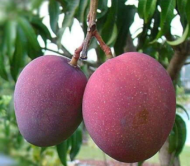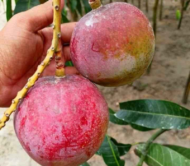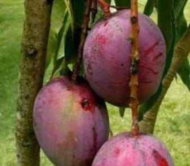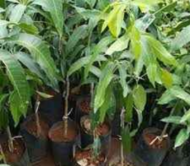-44%












₹420.00 – ₹4,500.00
Details:
🟡 Origin:
Developed in Florida, USA, around the mid-20th century.
Believed to be a seedling of the Haden mango, selected for commercial potential due to its size and storage life.
🍭 Taste:
Mildly sweet with a sub-acid tang, making it refreshing and less sugary than ultra-sweet varieties like Alphonso.
The taste becomes richer and more aromatic as the fruit ripens.
No fiber, making the flesh smooth and buttery.
🎨 Color:
Skin is greenish-yellow when immature, ripening to a deep red to purple blush on the sun-exposed side, and golden yellow on the shaded side.
Flesh is deep orange-yellow and visually appealing.
⚖️ Weight & Size:
Large-sized mango, typically weighing between 600 to 1,000 grams (0.6 to 1 kg).
Elongated oval to oblong shape.
🍬 Brix (Sweetness Level):
Brix content ranges between 16 to 18° Brix, indicating moderate to high sweetness.
Sweetness improves significantly when fully tree-ripened.
🍯 Sweetness Profile:
Less cloying than Indian varieties like Dasheri or Langra.
Balanced sweetness with a light tropical tang.
Ideal for those who prefer non-overpowering sweetness with subtle complexity.
🧵 Texture:
Fiberless, smooth, and firm flesh.
Excellent for fresh consumption, salads, smoothies, and slicing.
Would you like a comparison of Palmer with another mango like Kent, Tommy Atkins, or Nam Dok Mai?
| Weight | N/A |
|---|---|
| Dimensions | N/A |
| Size |
Large, Medium, Small |
The American Palmer Mango is a late-season, large-sized mango cultivar that originated in the United States, specifically Florida. Known for its impressive size, elongated oval shape, and striking coloration, the Palmer mango is a popular choice among both commercial growers and mango enthusiasts.
The fruit typically weighs between 600 to 1,000 grams, making it one of the heavier mango varieties. It has a smooth, tough skin that ripens to a beautiful blend of deep red, purple blush, and golden-yellow, especially when grown in sunny regions. This eye-catching coloration contributes to its appeal in both fresh markets and export.
The flesh of the Palmer mango is firm, fiberless, and deep orange-yellow in color. It is mildly sweet with a pleasant, sub-acid tang, offering a balanced tropical flavor that intensifies as the fruit matures. Its Brix level ranges from 16 to 18, indicating a moderate to high sugar content.
Palmer mangoes are slow to ripen, which extends their shelf life, making them ideal for shipping and storage. Their late harvesting season, typically August to October in the Northern Hemisphere, also allows them to fill a market gap when most other mango varieties are out of season.
1. Climate Requirements:
Best suited for tropical and subtropical climates.
Requires full sun exposure for optimal growth and fruit development.
Sensitive to frost; ideal temperatures range between 25°C to 35°C.
2. Soil Conditions:
Prefers well-drained, sandy loam or alluvial soils.
pH range: 5.5 to 7.5.
Avoid waterlogged conditions to prevent root rot.
3. Planting & Spacing:
Grafted saplings are recommended for true-to-type fruit production.
Plant spacing: 8 to 10 meters apart.
Dig planting pits (1m x 1m x 1m) and fill with a mixture of soil, compost, and farmyard manure.
4. Irrigation:
Young trees require regular watering until establishment.
Mature trees benefit from deep watering during dry periods, especially during flowering and fruit development.
Irrigation should be reduced as the fruit nears maturity to enhance sweetness.
5. Pruning and Canopy Management:
Requires light pruning after harvest to shape the canopy and remove diseased or dead branches.
Promote airflow and sunlight penetration for better fruit quality.
6. Flowering and Fruiting:
Flowers appear in late winter to early spring.
Cross-pollination enhances yield; bee activity is beneficial.
Fruits are ready to harvest approximately 4–5 months after flowering.
7. Pests and Diseases:
Susceptible to anthracnose, powdery mildew, and mango hoppers.
Regular spraying with organic fungicides and neem oil can help manage infestations.
Maintain orchard hygiene and remove fallen debris to prevent fungal spread.
8. Harvesting:
Harvested when the fruit develops full color and shoulder near the stem rises.
Handpicking is preferred to avoid bruising.
9. Yield:
Under good management practices, a mature tree can yield 100–200 fruits annually, depending on climate and soil fertility.
The American Palmer Mango stands out as a commercial and export-friendly variety due to its large size, attractive color, fiberless flesh, and extended shelf life. With proper cultivation practices, it offers a rewarding yield and premium market value, particularly in late-season mango markets.
Let me know if you need a comparison with other mango varieties or a BOQ for Palmer mango orchard planting.
No account yet?
Create an Account
Reviews
Clear filtersThere are no reviews yet.